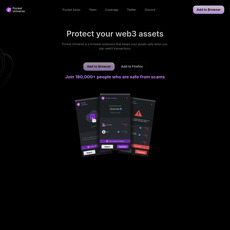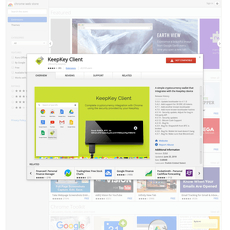Blowfish Review
Blowfish
blowfish.xyz
Blowfish.xyz: Blowfish Proactive Defense for Your Wallet – The Ultimate Review
Ever felt like your Web3 wallet is a sitting duck for hackers? With crypto crime hitting new highs, even the savviest investors feel nervous about keeping their funds safe. Phishing scams, wallet hacks, and fraud attempts seem to evolve by the hour. So, how can you truly lock down your digital assets?
Why Wallet Security is a Growing Concern
Here’s the reality: the blockchain world may be innovative, but it’s also a playground for malicious actors. In 2022 alone, crypto theft was estimated to exceed billions of dollars, with phishing attacks and fraudulent smart contracts taking center stage. Wallet providers are scrambling to keep up, but users are often left exposed to new and sophisticated threats.
Ward off a single scam, and it feels like two more pop up. But the burden shouldn't fall entirely on individual users. A growing problem is that most wallets simply don’t go far enough to address real-time threats, leaving thousands of assets unsecured. With crypto adoption on the rise, the security stakes have never been higher.
What’s Missing in Most Wallets?
If you’ve used a Web3 wallet long enough, you may have already spotted the gaps. Sure, most wallets offer password protection, maybe 2FA, and some basic seed phrase back-ups, but let’s face it—
- No real-time fraud detection: Hackers can exploit vulnerabilities in seconds, but many wallets rely on outdated guardrails.
- Lack of proactive alerts: Wallets often miss warning users about hidden malicious contracts or phishing sites before it’s too late.
- Static algorithms: Threat actors upgrade their tactics, and most wallet defenses can’t evolve quickly enough to adapt.
This reactive approach leaves crypto holders constantly playing defense, trying to address attacks only when they’ve already happened. It’s a frustrating—and sometimes catastrophic—game that most of us are tired of playing.
Enter Blowfish.xyz: A Proactive Solution
Here’s why Blowfish.xyz is turning heads: it promises a security system that doesn’t just respond to threats—it’s designed to anticipate and shut them down proactively. Think live fraud detection, multi-chain support, and tech that’s a step ahead of the bad guys. But does it hold up? Is Blowfish the extra shield every wallet user has been looking for?
This is where it gets interesting. Crypto needs solutions that don’t just keep up with today’s threats—they need to see tomorrow’s. Blowfish claims to fill this gap by monitoring transactions, identifying risks in real-time, and blocking attacks before they even start. Can it really deliver the ultimate safeguard? Or is this too good to be true?
What You’ll Learn in This Review
If you’ve ever wondered whether a Web3 security tool can live up to its hype, you’re in the right place. We’ll look into how Blowfish’s encryption works, whether it’s the proactive defense we’ve been waiting for, and whether it leaves crypto users with peace of mind. After all, nothing beats confidence when it comes to your wallet security.
Ready to find out what makes Blowfish different? In the next section, we’ll break down exactly what Blowfish.xyz is and how it operates. So, what powers this proactive defense, and does it stand out in the crowded world of Web3 wallet protection? Let’s see what’s under the hood.
What is Blowfish.xyz?
Blowfish.xyz is more than just a tool; it’s like having a loyal guard watching over your web3 wallet 24/7. Designed specifically to catch fraud before it even thinks about stealing your funds, this security engine brings a proactive edge to wallet protection that most crypto users desperately need. With rising scams and hackers constantly scheming their next move, Blowfish promises to spot the threats faster than they ever imagined possible.
Key Features Overview
Let’s get straight into what makes Blowfish.xyz shine in a world where security is everything. Here are its core features:
- Real-Time Fraud Detection: No more guessing games. Blowfish doesn’t wait until after your funds are at risk—it acts instantly, shutting down threats in real-time.
- Multi-Chain Support: Supporting over 10+ blockchain networks, including big names like Ethereum, Binance Smart Chain, and Solana.
- Easy Integration: Wallet providers and developers will appreciate how simple it is to implement Blowfish into their systems.
Each feature feels crafted to fill the gaps left by traditional security protocols. But it’s not just about ticking boxes—it’s about delivering real protection where it matters the most.
Why the “Proactive” Defense Claim Stands Out
Let’s face it: we’ve all seen security tools that only act after damage is done, leaving you to clean up the mess. Blowfish isn’t interested in being late to the party. Its proactive defense system is like having eyes in the back of your head—it promises to intercept fraud, phishing attempts, and malicious transactions before you even realize they’re happening.
This kind of approach changes the entire security game for web3. It’s comforting to think that instead of logging in to a nasty surprise, you’ll receive an alert that a threat was stopped dead in its tracks.
“If you think the cost of securing your assets feels high, wait until you’ve lost them.”
There’s something reassuring about knowing a system isn’t reactive but rather designed to block the problem altogether. And honestly, in a fast-moving space like crypto, this could be the difference between sleeping soundly or pulling an all-nighter to recover stolen funds.
How Blowfish Fits into Modern Crypto Safety Needs
The crypto space moves at lightning speed. With new blockchain innovations popping up every minute, the tools we rely on for safety need to evolve just as fast. Blowfish seems to come at just the right time, catering to a new generation of wallet providers and users who demand smarter, faster, and more adaptive security solutions.
Fraudsters and scammers are no longer relying on old tricks—they’re advancing too, using AI-powered phishing attempts and sophisticated attacks. Blowfish’s system aligns perfectly with this shift. It’s not stuck in yesterday’s game; instead, it’s playing ahead, analyzing potential dangers and adapting to beat them at their own craft. That’s exactly the sort of tool web3 enthusiasts have been crying out for.
But here's the big question: Does Blowfish’s encryption system provide the backbone it needs to deliver on these promises? Could a “legacy” encryption method compromise this cutting-edge approach? Let’s check out what’s coming next.
The Blowfish Encryption System: Is It Still Good in 2023?
You’ve probably heard the phrase "what worked yesterday might not work today." Encryption is no different. Blowfish has been around for a while, and to be blunt—some wonder if it’s still sharp enough to cut through the increasing complexity of today’s cybersecurity challenges. So, let’s take a closer look at this encryption system, how it measures up today, and whether it can still hold its ground in the shifting landscape of web3 security.
Comparing Blowfish to Other Encryption Algorithms
If you’ve been keeping an eye on encryption technologies, names like AES (Advanced Encryption Standard) and RSA might ring a bell. These are the big players in modern security, often viewed as "gold standards." But how does our friend Blowfish compare?
- Speed: Blowfish is known for being incredibly fast, particularly when it comes to systems requiring high performance. That’s why it’s still prioritized in scenarios where speed can’t be compromised.
- Key Size: With adjustable key sizes ranging from 32 to 448 bits, Blowfish offers flexibility, which isn’t always the case with newer algorithms like AES. This makes it customizable for different levels of security needs.
- Strength: While AES is often considered stronger for government-level encryption due to its larger block size (128 bits vs. Blowfish’s 64 bits), Blowfish’s structure is still robust enough for securing everyday applications, including web3 wallets.
Here’s a thought-provoking quote for you:
“Security is not a product, but a process.” – Bruce Schneier, inventor of Blowfish.
It reminds us that no single algorithm is perfect; what matters is how it’s applied and updated to meet current threats.
Blowfish’s Real-World Application in Web3 Security
Here’s where things get exciting. Blowfish isn’t just some dusty old encryption system sitting on the shelf—it’s actively transforming web3 wallet security. Let me break it down for you.
For example, when a malicious transaction attempt rolls in, Blowfish’s system encrypts and analyzes data in real-time. This means any suspicious data packet gets flagged before it can do harm. Wallets integrated with Blowfish benefit from this protection. Imagine opening your wallet and seeing a red flag for a fraudulent transaction that never had the chance to go through. That’s the proactive energy Blowfish brings.
Additionally, its multi-chain support ensures that wallets dealing with Ethereum, Polygon, or other chains can rely on the same standard of encryption across the board. Having consistent security across multiple blockchains is critical—after all, hackers don’t limit themselves to just one network.
Concerns About It Being a “Legacy” System
Okay, let’s address the elephant in the room. The word “legacy” sometimes gets thrown around as if it’s a bad thing, but is Blowfish really outdated? Not quite. While it’s true that Blowfish was created in the '90s, its simplicity and efficiency have allowed it to adapt well to modern needs.
The fact that it’s still in use in 2023 speaks volumes. But there’s always a flip side. Some critics argue that its block size (64 bits) could become a bottleneck as larger datasets are processed in web3 environments. Still, users should keep this in perspective. Blowfish was never designed to replace every form of encryption—it excels in specific scenarios where speed, flexibility, and reliability matter most.
Plus, let’s not ignore the legacy of trust. Many wallets wouldn’t touch this system if it didn’t deliver top-tier protection. The question isn’t so much about whether it’s “old” but whether it still gets the job done—and for now, the answer seems to be yes.
But is trust alone enough? Or would you like to see exactly how wallets leverage Blowfish to stop fraud before it happens? Don’t miss out on what's coming next—I’ve got eye-opening real-world fraud detection examples that’ll make you truly appreciate how this technology is saving wallets and protecting funds. Let’s explore that next!
Blowfish in Action: Real Fraud Detection Examples
Security doesn’t hit home until you see it in action. Let’s face it, features on paper are great, but nothing builds trust like real-world proof. That’s where Blowfish shines. Their fraud detection system isn’t just marketing hype—it’s actively protecting web3 wallets right now. Here’s how.
Case Studies From Wallets Using Blowfish
Let me paint the picture: imagine you're about to approve a transaction on your wallet, and right before you confirm, a red flag goes off. That’s Blowfish at work. Their integration has helped several wallets stop fraudulent attacks before they could ruin someone's day. Here's an example that really stood out:
- Avoided Millions in Losses: A popular wallet provider shared that, within 6 months of using Blowfish, they blocked hundreds of phishing attempts targeting users. In one case, a high-net-worth user almost approved a malicious transaction worth over $2 million. Blowfish flagged it instantly, saving the user from disaster.
- Phishing Link Protection: Websites mimicking official wallet platforms trick users into entering credentials. Blowfish’s system spots these tactics, analyzing URLs in real-time to put an end to the scam before the user falls victim. Wallet support teams reported a 30% drop in fraud-related complaints post-Blowfish integration.
It’s no wonder wallet providers keep singing Blowfish’s praises. This isn’t just software; it’s a guardian watching out for you.
What Users Are Saying About Blowfish
The truth always comes out in user feedback, doesn’t it? When it comes to Blowfish, I’ve seen overwhelmingly positive comments across forums and social media. Here’s what actual users have shared:
- “I got an alert just as I was about to sign a suspicious transaction. I checked it out, and sure enough, it was a phishing attempt. Without Blowfish, I would’ve lost everything.” – Ethereum user on Reddit
- “Blowfish feels like having an extra layer of awareness. I don’t just trust my wallet now; I trust what Blowfish is doing in the background.” – Crypto enthusiast in a Telegram group
- “It called out a malicious smart contract that looked completely harmless to me. Now I can’t imagine using a wallet without it.” – NFT collector on Twitter
These stories hit close to home. Losing funds in seconds is a nightmare no one should face, and Blowfish helps ensure they don’t.
Potential Gaps in Detection Systems
Now, is it perfect? Almost, but not quite. While Blowfish’s proactive approach is ahead of the curve, no tool catches everything. Some users have noted that certain niche phishing tactics or obscure smart contract exploits might slip through undetected.
Also, crypto is a cat-and-mouse game where hackers constantly evolve. While Blowfish updates frequently to battle new threats, you might wonder: Can they always stay one step ahead?
Here’s the thing: Blowfish isn’t claiming to be the ultimate “end-all” tool (let’s be honest, nothing is). It’s about drastically improving your odds, and so far, it’s doing that really well. But this raises an important question: does Blowfish’s blockchain compatibility and integrations make it easy for wallet providers to deploy? The answer might surprise you, and we’re covering that next.
Supported Chains and Developer Integration: Making Security Accessible
How well does Blowfish mesh with the fast-paced world of blockchain? If you're a wallet provider or developer, you'd want a security engine that's as adaptable as you are ambitious. After all, security is only as effective as its ability to keep up with modern demands. Blowfish seems to promise a lot here. Let’s see how it delivers.
Blockchain Compatibility
Blowfish currently supports an impressive range of popular blockchains, including heavyweights like Ethereum, Solana, and more. In fact, its list of supported networks is actively growing. This is no small feat—the ability to operate across multiple blockchains means broader accessibility for users and developers alike. Companies no longer have to worry about platform limitations when integrating robust security.
Think about it: whether you’re building on Ethereum's smart contracts or Solana's high-speed protocol, Blowfish promises to adapt seamlessly. That’s flexibility designed with modern crypto builders in mind.
Ease of Implementation for Developers
Let’s be real here—security tools tend to be a nightmare to integrate, right? Thankfully, Blowfish seems to understand the pain points of developers. Their system is marketed as “plug and play.” Simple APIs allow developers to embed Blowfish security layers into their wallets with minimal coding or headaches.
One feature worth highlighting is their detailed developer documentation and transparent support system. Easy access to guides, walkthroughs, and sample codes means you’re not wasting hours trying to figure things out. Whether you're a seasoned blockchain dev or a startup wallet provider testing the waters, the process feels approachable, not over-engineered.
Here’s a fun thought: what if security integration was as efficient as deploying a simple smart contract? Blowfish claims to make that a reality.
Partnerships with Major Wallets
When it comes to trust, nothing screams reliability more than seeing big names placing their faith in a system. Blowfish boasts partnerships with some of the largest wallets in the crypto space—names like Phantom, Trust Wallet, and others are reportedly using Blowfish's security engine to keep users safe.
One standout example? Solana's Phantom wallet, which has faced its fair share of phishing attacks, has successfully improved its defenses using Blowfish. By proactively blocking suspicious transactions before they execute, Phantom has showcased how Blowfish isn’t just all talk—it’s working in the wild.
And here's where it gets interesting: Blowfish doesn’t just stop at big wallets. Even smaller startups have started adopting its solutions, showing that the barrier to entry isn’t astronomical. Whether you’re a wallet titan or just starting out, Blowfish aims to have your back.
“The strength of your security lies in the partnerships you keep.”
Reading this, you might wonder, does supporting all these chains and being easy to integrate actually keep up with the ever-evolving threats of the Web3 space? How does Blowfish handle the constant advancements and scams that seem to grow smarter by the day? If you’ve got that question brewing in mind, stick around—let’s explore how Blowfish stays razor-sharp when it comes to tackling evolving threats.
Blowfish’s Proactive Approach to Evolving Threats
The crypto landscape is like a never-ending chess match—you make a move, the bad actors make one right after. Staying ahead of the game is tough, which is why Blowfish’s approach to evolving threats caught my attention. They don’t just defend against yesterday’s hacks; they’re preparing to handle tomorrow’s scams, too.
Adapting to New Scams and Phishing Tactics
Every day, scammers come up with fresh schemes targeting unsuspecting crypto holders. It’s not just about stealing private keys anymore; phishing scams have become smarter, and address spoofing is at an all-time high. According to a 2023 report by Chainalysis, crypto scams accounted for billions of dollars in stolen funds last year alone. This is where Blowfish really shines—it actively monitors trends in fraud.
The platform’s system dynamically analyzes web3 scams, updating its detection algorithms to reflect the latest threats. Say a scammer develops a clever new trick targeting NFT marketplaces—they’re not waiting months to patch it. Blowfish automatically deploys protections to safeguard users ASAP. It’s like having security that evolves with each new scam attempt.
Automation and AI in Threat Detection
Let’s talk about speed and intelligence. Blowfish doesn’t rely on humans to flag suspicious activity—it uses AI to scan millions of transactions across multiple blockchains in real time. This system is all about automation, which means faster reaction times and fewer vulnerabilities slipping through the cracks.
Here’s where it gets interesting: Blowfish uses machine learning to identify patterns that even seasoned developers might miss. For example, if an attacker’s tactics subtly shift across chains like Ethereum and Solana, the AI adapts instantly. The platform has automated alerts that trigger when red flags pop up, notifying both users and wallet providers. This meticulous attention to detail is what makes them stand out in today’s high-stakes crypto world.
Trust Factor: How Reliable is Blowfish Really?
Okay, so it’s high-tech, but is Blowfish dependable when it truly counts? Based on everything I’ve seen, this tool walks the walk. It’s been battle-tested by major wallets and hasn’t bowed under pressure—not yet, at least.
But let’s address the elephant in the room: long-term reliability. Can Blowfish deliver consistent protection year after year? One thing I’ve noticed is how aggressively the team invests in updates and user trust. They’re not sitting back; they actively improve their framework, making them more resilient to future web3 exploits.
"The best defense isn’t fighting fraud as it happens; it’s making sure it never gets that far." — Anonymous Web3 Security Expert
Still, I’d be curious—can they maintain this momentum as the stakes get higher? Could there be limits to this proactive system? These are questions every crypto enthusiast should ask, especially if you’re staking your assets on tech like this.
Here’s a question for you: How does security like this feel to the everyday crypto user? Is it smooth sailing or does it come with its own set of quirks? Stick around; I’ll break it all down next.
Blowfish User Experience: What’s It Like for Average Crypto Holders?
We all know that no matter how powerful a technology is, what really counts is how it plays out in our day-to-day life. Blowfish might be packed with cutting-edge defense, but is it approachable for the everyday crypto user like you and me? Let’s take a look at what using this security system actually feels like.
Notifications and Alerts for Suspicious Activity
Imagine this: you’re about to approve a transaction in your web3 wallet, and suddenly, a notification pops up. It’s not just any alert—it’s Blowfish flagging a red flag in real-time. Maybe it detected a connection to a known phishing site or spotted unusual transaction patterns. Whatever it is, it gives you the heads-up before any damage is done.
That’s the kind of proactive security Blowfish offers. It doesn’t just leave users in the dark until it’s too late. For example, users have reported getting alerts when interacting with fake wallet connection requests. Instead of blindly approving a malicious smart contract, they were warned and stopped just in time. And the fact that it works silently in the background until action is actually needed makes it feel even smarter and less intrusive.
The real-time notifications keep you in control, *without drowning you in unnecessary tech details*. As someone once said, “The best security systems are the ones that work for you, not the ones that rely on you.” Blowfish seems to embody that philosophy perfectly.
Design Simplicity vs. Behind-the-Scenes Complexity
Let’s talk about usability—one area where some security solutions break trust. If a tool feels like it’s designed for an engineer, not a regular person, it’s doomed. But here’s where Blowfish surprises me. Its alerts and integration feel simple on the surface, almost too simple to realize how much technical heavy-lifting is happening in the background.
For instance, you don’t need to scroll through lengthy logs or know how cryptography works. Blowfish simply gives the kind of actionable updates you actually understand. "You might be at risk" is the kind of clear message your average wallet user *wants*, rather than drowning them in dense reports they don’t even have the tools to interpret.
Still, if you’re curious about the complex protections under the hood, Blowfish’s use of advanced cryptography and multi-chain compatibility reassures you that it’s not cutting any corners. It’s built for crypto nerds but *translated for the rest of us*. This makes it user-friendly for every type of crypto holder, whether you’re new or seasoned.
Possible Downsides of Using Blowfish
Okay, here comes the critical bit—because every tool has its quirks, doesn’t it? One potential downside is that Blowfish’s proactive nature might throw out alerts during low-risk scenarios. For instance, users managing frequent high-volume transactions might occasionally deal with over-cautious flags. Think of it like your overly suspicious friend—always watching out for you but sometimes jumping the gun.
Another thing to think about is whether Blowfish will fit seamlessly into your existing wallet setup. While it’s highly integrated with notable wallets, some crypto holders prefer third-party tools to be **100% optional**. As of now, Blowfish handles this well in most cases, but you might want to double-check its compatibility with the wallet you frequently use.
Still, minor inconveniences like these are a small price to pay for the peace of mind you get. Wouldn’t we all rather prevent false positives than deal with actual losses?
But here’s the question: what’s the catch? What’s accessibility like, and how much is all this security going to cost? Stick around, because we’re about to break it all down.
Pricing and Availability of Blowfish
Let’s be honest, when it comes to making decisions about a security tool, cost is one of the first things that pops into your mind. So, how much does Blowfish cost? And is it something everyone can easily access? Let’s break it down and take a good look at what Blowfish has on the table for different wallets, developers, and users.
Free Trials or Demos: Can You Test Before Committing?
The good news? Blowfish makes it easy for wallet providers to dip their toes in the water without committing upfront. Yes, they offer free trials and demos! If you're running a wallet startup or considering integrating the tool, this is a big win.
Think about it—being able to test the system’s real-time fraud detection and multi-chain compatibility before dropping a cent is a fantastic way to see if it’s the right fit for your needs. Many security providers skip this step, but Blowfish offers this option to help you decide if their proactive approach to wallet defense truly stacks up to your expectations.
Long-term Pricing Strategy
Now, let’s talk dollars. Blowfish pricing seems to be structured in a way that scales based on the needs of the customer. Whether you're a scrappy startup looking to ramp up your wallet security or a large, well-established crypto wallet company safeguarding millions in user funds, there’s likely a pricing tier designed for you.
This model is handy for businesses of all sizes. It acknowledges that smaller wallets probably can't dish out the same amount as industry giants, but they still deserve access to quality proactive security. Blowfish appears to balance accessibility with functionality, making it a solid choice for developers and wallet providers alike. While exact numbers aren’t publicly emphasized, the focus on flexibility is encouraging.
Here’s the kicker: Blowfish seems to actively avoid locking users into cookie-cutter plans. Instead, they focus on long-term partnerships. This is a strong sign that they’re not just looking to sell a product—they want to build trust as the go-to solution for wallet safety.
But is this pricing strategy as good as it sounds? And does Blowfish really deliver the value to match its cost? It’s easy to wonder, and honestly, it’s one part of the equation where actions speak louder than words.
So, here’s my question for you: How much is peace of mind worth when it comes to protecting your funds and reputation? Is Blowfish ready to become the ultimate game-changer for wallet security? Stay tuned for the full wrap-up where I’ll break it all down in the final part of this review.
Wrapping it up: Should you trust Blowfish.xyz for wallet defense?
Final verdict on Blowfish encryption and security features
Let’s cut to the chase—Blowfish.xyz has proven itself to be a strong contender in the world of wallet protection. Its proactive defense strategy, live fraud detection, and multi-chain support make it one of the more advanced options for safeguarding your crypto. The fact that it catches threats before they even reach your wallet is a game-changer. However, no system is bulletproof. While Blowfish ticks a lot of boxes, it's essential to treat it as part of a broader security strategy—not the entire safeguard for your portfolio.
If you’re looking for a tool that balances ease of use with powerful protection, Blowfish does an excellent job. The encryption tech still holds up against modern threats, and the AI-powered detection systems keep it evolving with new scams. In short—yes, it’s worth a shot if you’re serious about wallet safety.
Alternatives to Blowfish
Not 100% sold on Blowfish? That’s okay—there are other fish in the crypto sea. Here are a couple of solutions you might want to check out:
- OpenZeppelin Defender: A solid choice for developers, focusing on securing smart contracts with automation tools.
- Sec3 AI: A newer platform that takes an AI-centered approach to blockchain threat detection.
These alternatives might fit better depending on your specific security needs, so it’s worth exploring them before making a final decision.
Where to go next for more info
If you’re ready to learn more, the best place to get started is Blowfish’s official website. They’ve got detailed info about their features, integrations, and how to get started. You can also explore developer forums and Twitter discussions to see what people are saying about Blowfish in real time. And, of course, keeping tabs on crypto security news never hurts—it helps you stay ahead of evolving threats.
My honest take
Here’s what I think: Blowfish is legit. It's proactive, easy to integrate, and has a clear focus on staying relevant in a fast-changing crypto world. It isn’t perfect—no tool is—but it gives you a fighting chance against many of the scams and attacks we see these days. Personally, I’d use it as an added layer of defense for my own holdings.
That said, I wouldn’t put all my trust in one solution alone. The crypto space is unpredictable, and having a multi-pronged security approach is always the smarter move. Blowfish can be a big part of that, but don’t forget to combine it with good wallet hygiene, strong passwords, and, of course, your instincts. Stay sharp, and stay safe out there.










